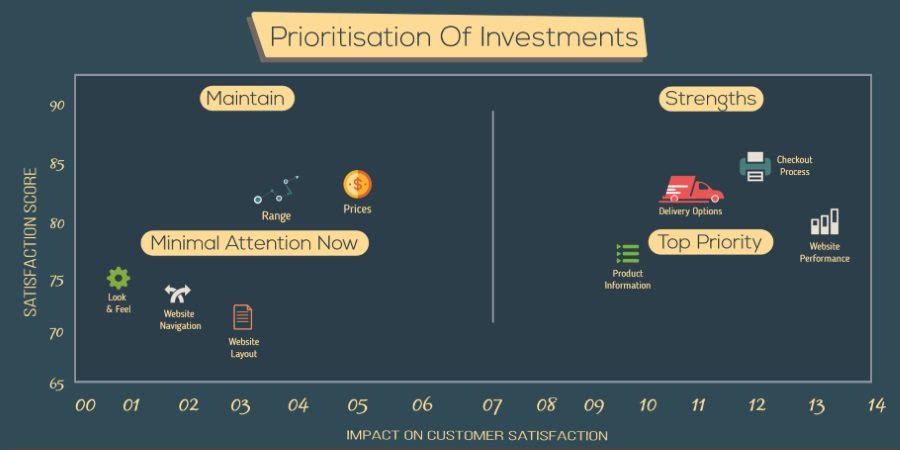
by Saraswati K. Mehta | CFI Group UK | September 21, 2017
Businesses need to wisely prioritise where to invest. It may not be the squeaky wheel that always needs the grease.
Recently, as I had been thinking of upgrading myself to a wireless format, I bought a new pair of headphones. I had no real reason for the upgrade, so you can say I just wanted to be part of the trend, or perhaps just needed retail therapy (!). As with most of my shopping these days, online search and browse was my first step.
I scanned through a couple of websites with a clear inclination of making my purchase from the website I’ve used in the past. Though I regularly shop online, I’m still wary of shopping with new/unfamiliar websites, aiming to avoid any unforeseen payment or delivery hassles.
I started browsing my usual shopping website, one of the leading ecommerce retailers. While scanning through the headphone offerings on the site, I realised that it was quite cluttered and somewhat hard to navigate. In fact, it took me a long time to figure out whether or not I had browsed the complete range of headphones available. I was frustrated with the site’s poor layout and navigation.
My lower satisfaction with the layout and navigation did not severely damage my shopping experience because there were other factors that had a greater influence on my shopping experience.
Why would a leading ecommerce retailer allow its online shop to be cluttered and hard to navigate, I wondered. It seemed implausible that they would never have thought of improving this area of their business, since they so smartly use technology for other areas of the website.
I then put on my marketing hat and considered the business objectives for this popular ecommerce retailer. I realised that although the website is difficult to navigate, it does its job of not only converting browsers to purchasers but also drawing them back to come and shop again.
If the site is accomplishing its objectives, then, is it right to say that the website layout and navigation do not matter to the customers?
If I, as a consumer, rated this website for its layout and navigation on a scale of 1-10, I’d end up at the lower end of the scale. That said, I was still highly satisfied with all other features of this website, such as:
- The brilliant search/filter functions that allowed me to streamline the range of products within my needs criteria
- The same/next day delivery options, which meant I did not have to wait long to get my purchase in hand; it was just like shopping in-store
- The smooth checkout process
My lower satisfaction with the layout and navigation did not severely damage my shopping experience because there were other factors that had a greater influence on my shopping experience. The influence of these other factors may demonstrate why this retailer does not need to improve its website layout and navigation. In short, the retailer seems to know which factors are important.
So, how can a retailer determine which areas of business have a relatively high impact on customer satisfaction and their shopping behaviours?

At CFI Group, we call this "business driver prioritisation." When it comes to investments for improvements, businesses need to wisely prioritise where to invest. It may not be the squeaky wheel that needs the grease!
From my website example above, the Website Layout and Website Navigation have the lowest performance (i.e., Scores). You could say the poor layout and navigation are “squeaking” more than other areas of business because they perform the worst.
But layout and navigation don’t have as large of an impact on customer satisfaction with the experience as do the other areas of the website, such as search functionality, delivery options, and checkout process. Based on our analysis, these areas have more influence on the customer experience than layout and navigation.
Once you have clarity on priorities, you can work to maximize ROI on your improvements . . . and make sure the grease goes where it belongs.
CFI Group helps businesses prioritise improvements based on a credible metric so that you make investments where you’ll realize the greatest ROI—in customer experience, loyalty, sales, and other areas vital to your business. Let us help you optimise customer satisfaction and maximise ROI on your improvement plans.
Other Resources
- Date
- September 7, 2023
by David Ham | September 7, 2023 With the amount of money involved in professional sports contracts, the current trend toward deeper analysis makes good business sense. However, […]- Date
- June 2, 2023
by David Ham June 1, 2023 I will start by stating the obvious, inflation is forcing consumers to make tradeoffs and difficult decisions. This puts businesses […]- Date
- August 1, 2022
by David Ham August 1, 2022 Five years ago, I wrote a blog that asked, Is This a ‘Hook-Up’ or a Long-Term Relationship? The post was […]- Date
- May 24, 2022
by Omar Khan May 24, 2022 A few years before getting my first job as a consultant, I spent a summer abroad in the United Arab […]





